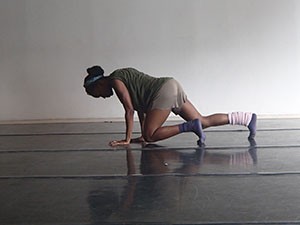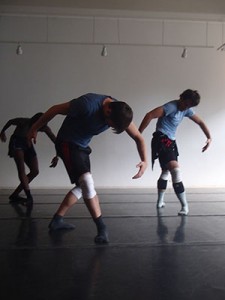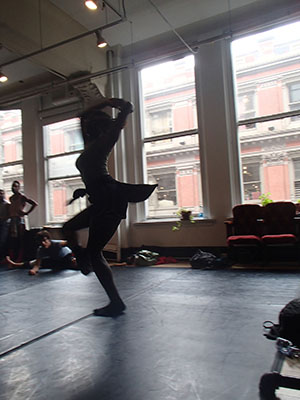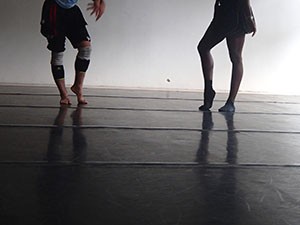Student Spotlight: Keeping Up with Kyle Abraham
Editor’s note: During the summer of 2014, UMS launched a new 21st Century Artist Internships program. Four students interned for a minimum of five weeks with a dance, theater, or music ensemble that is part of our 2014-2015 season. Sophia Deery is one of these students. She spent the summer in New York with Kyle Abraham and his company Abraham.In.Motion and recounts her experiences below. Abraham.In.Motion brings their innovative choreography to UMS on March 13-14.

Tamisha Guy rehearses “When The Wolves Came In,” which partially draws inspiration from a tragic accident involving wild African dogs at the Pittsburgh Zoo in 2012.
“Sister Sophia!” Sister Sophia – that’s me. “Sister Sophia, could you come here and film this run?” That’s Kyle Abraham, founder, choreographer, and dancer of Abraham.In.Motion, the NYC based-dance company which emerged on the scene in 2006, and became one of the hottest tickets in the city this season with its critically acclaimed two-night program at New York Live Arts in September. I was able to intern with Kyle and the company from July through August of this past summer under the auspices of the newly created 21st Century Artist Internship through the University of Michigan’s University Musical Society. This was a fascinating time to be with the company, not only because it immediately preceded their NYC premiere of The Watershed, and When the Wolves Came In, and would involve helping to plan a major European tour, but because it was – and still is – a time when the company itself was undergoing a major internal transformation.
I came to AIM as they were nearing the end of their two-year residency at New York Live Arts. The residency is a valuable one. It allots a space and funding for a given artist to develop and perform new works in a beautiful building in Chelsea which houses a full theater, offices, and several state of the art studios. For those not familiar with New York Live Arts, it is a non-profit organization that was the result of a 2011 merger between the renowned Bill T. Jones/Arnie Zane Dance Company and Dance Theatre Workshop. In addition to this residency, Kyle had received a MacArthur “Genius” fellowship in 2013, and the company was changing shape from a pick-up model where dancers would work on a project-by-project basis, to a resident company. The difficulty is if you want dancers to make your company their priority, you have to enable them to support themselves. I had the invaluable opportunity to sit in on many meetings about budgets, the hiring of new dancers and staff members, ideas for social media campaigns, and the scheduling of performances that seemed incredibly far into the future. My own administrative tasks included writing up and sharing weekly rehearsal schedules and booking locations for the rehearsals at various dance spaces all over the city… all the while staying in budget. What I witnessed on the administrative side of the internship was, in essence, the growing pains and excitements of a small dance company, moving up to take its place as a major player in the dance landscape.
“I hope it’s good.” Kyle says to me, stretching out across the marley floor, sock-feet splayed, eating the chicken salad I had picked up for him. Rookie-intern that I am, I had made the mistake of forgetting a fork, necessitating a second trip down 6 floors and across the street, back to the deli where the cashier already thought I was crazy for spending 15 minutes trying to decide if I should get regular chicken salad, because they didn’t have the curried kind he had asked for. (The regular was fine, it turned out). I have learned a lot of things about Kyle from working as his intern. He is a very picky eater, enjoys Auntie Anne’s pretzels (original salted) and lemonade, and hates cheese. “I hope it’s good” was not referring to the chicken salad, however, but to the two programs he was rehearsing that day for their upcoming premiere. His openness and self-deprecation leave me wondering if he really cannot see the power of the piece that has left me breathless even after the tenth run. I have learned that it can be hard directing a company of dancers, now no longer all people with whom you graduated from college, but a new, younger group who look to you as a leader. He navigates a fine line between knowing when to adhere to divisions of authority structure that divide dancer and choreographer or artistic director, and when relaxing these divisions and goofing around is essential to group cohesion. I have learned that Kyle likes to send emails ending in a inscrutable “…” which leaves the recipient slightly panicked, wondering exactly what that last implied piece of information was…

Long-time company member, and newly appointed company liaison Matthew Baker (an Ann Arbor native!) leads auditioning dancers through choreography.
“Sister Penda!” Kyle calls in a laid-back drawl, as dancer Penda N’diaye makes her way over. Kyle’s speech alternates between a familiar, affectionate, urban drawl tinged with the occasional “y’all,” which he uses with his dancers, and rapid, academic articulation when he talks about his ideas, inspirations, and influences. These are many, and indicate a cultural and artistic literacy that is wide as it is deep. Born and raised in Pittsburgh and immersed in urban youth street culture, educated at SUNY Purchase where he studied classical and modern dance, then to NYU where he received an M.F.A., a former classical cellist and briefly an employee at the Andy Warhol museum, Kyle’s education, much like his choreography, follows no conventional pattern. Additionally, he is a black, homosexual man, at a time in our country’s history where we are still deciding exactly what it means to be both. It is no doubt because of this unconventional path that Kyle’s choreography incorporates such a variety of styles (ballet, hip hop, contemporary, Graham, etc.), subject matter (Emancipation Proclamation, identity, modern sexuality, apartheid, protest), music (Max Roach, Robert Glasper, Drake, Italian Opera) – and despite the incredible breadth of its spectrum, it always rings true. Every piece comes off like a first person account of a real life experience. Like his speech, they are unaffected, but very effective.

New A.I.M. dancer, statuesque Penda N’diaye, practices on the side during a rehearsal at Gina Gibney Studios.
Kyle expects this same malleability and authenticity from his dancers. His auditions, which I was fortunate enough to witness rather than experience, are a grueling process. When I asked Kyle what he looks for in a dancer, hoping honestly to get some inside-scoop for when I’m back in New York, he said that he looks for someone with dance ability and/or training across several techniques like Graham, Limon, classical ballet, Horton, hip hop, etc. As he ticked off historic dance makers and various techniques, I thought of how broad a dancer’s education has to be nowadays in order to remain competitive and successful in the field. They have to take direction which morphs technical terms like “a la second leap and then lateral T” immediately followed by “hood rat, booty poppin’, gum chewing” into “soldier walks.” This is not a one-trick pony company; indeed fewer and fewer are. Ballet company seasons are increasingly including works by Paul Taylor and Twyla Tharp, making dancers’ versatility vie with their perfect 32-count fouettés among their most marketable skills. Our conversation made me wonder what type of education provides this – how does the modern professional dancer train? I spoke with the company dancers about their various backgrounds and training, and found that many of them had pursued degrees in dance following high school, while others had immediately begun professional careers. Varying backgrounds aside, the common denominator for all of Kyle’s dancers is their intellect. The versatility he demands extends beyond the physical. As evidenced by the myriad sources from which he draws his inspiration, this is a company in which intelligence, and an understanding of the concept of each piece is essential to being able to perform it with integrity.
Two men lunge and shoot their arms up in a high V, fingers in a gesture suggestive of an old time cowboy at a gun show, or perhaps a gang member throwing up his allegiance, but the hands don’t stop there and move immediately into a high fifth position which then travels down the body to first position while their torsos synchronize in a liquid body roll. In my favorite piece, a trio called Hallowed, gospel music fills your ears as you watch three dancers alternate between a slow strut, lazily waving their arms with deadened eyes – and the rapid, aggressive arm gestures of a dance-off, eyes alive with anger or indignation. The first conjures images of paper fans, of hard church benches, of heat, and perhaps a more sinister oppression. The contrast between the two styles of movement seems to me a dramatization of the tension existent between resignation and protest.
These few examples show some of what makes Kyle Abraham unique as a choreographer: there is a story – told in recognizable pedestrian movements which are generic only in the sense that they are universal and recall things the audience has experienced, wished, or feared. Sketched situations of human existence, they allow us to do some coloring in. Seamless transitions from the pedestrian, to modern dance vocabulary, to hip hop and social dance, give the impression that Kyle is not so much juxtaposing contrasting styles of movement, or worlds for that matter, but rather elegantly weaving them together in a new type of concert dance. This is not schoolyard hip hop, nor a purist’s classical dance. While it incorporates elements of both, it also has roots in the real, the commonplace, the grit and injustice, problems we have faced in the past, and those we are grappling with now, and yet simultaneously it transcends them. At once personal and universal, and never more timely, the pair of The Watershed and When the Wolves Came In is like a diary entry written in the curves of spines, the bends of elbows and shifting patterns of light.
To view more of Sophia’s photography, see the gallery below.









